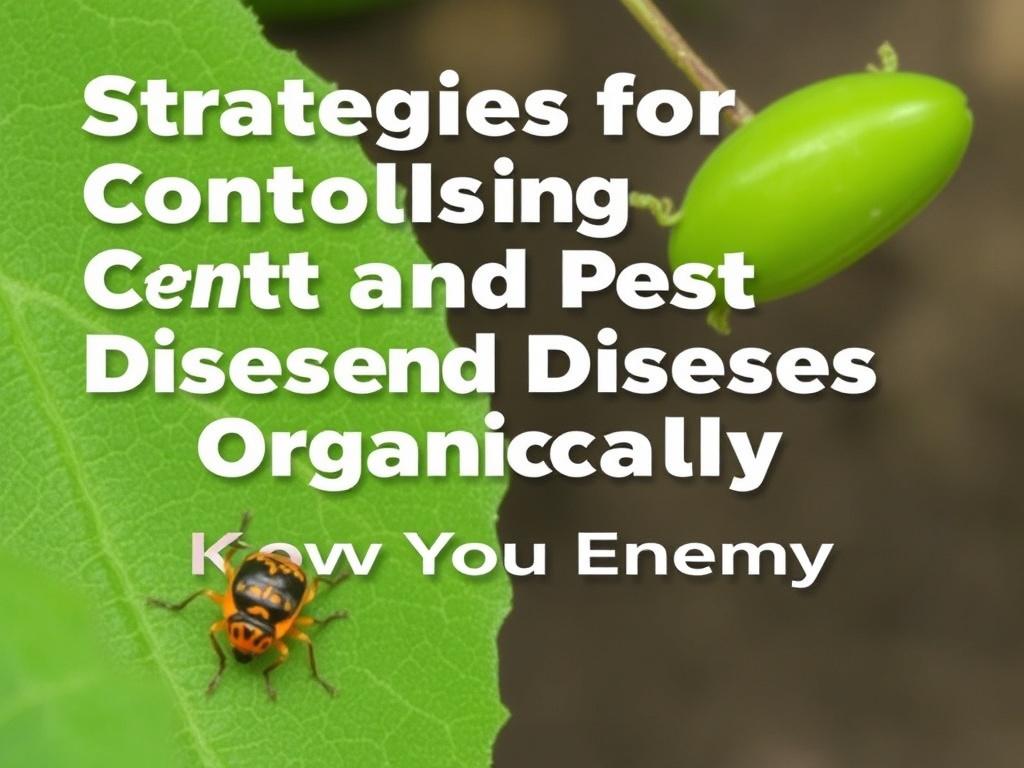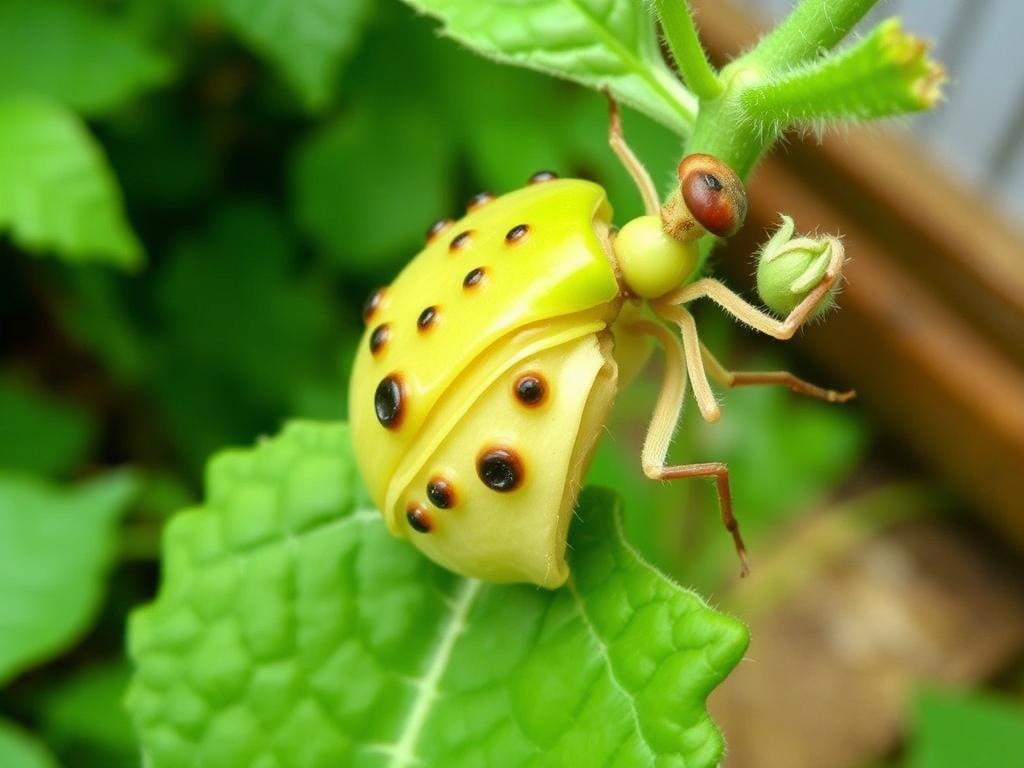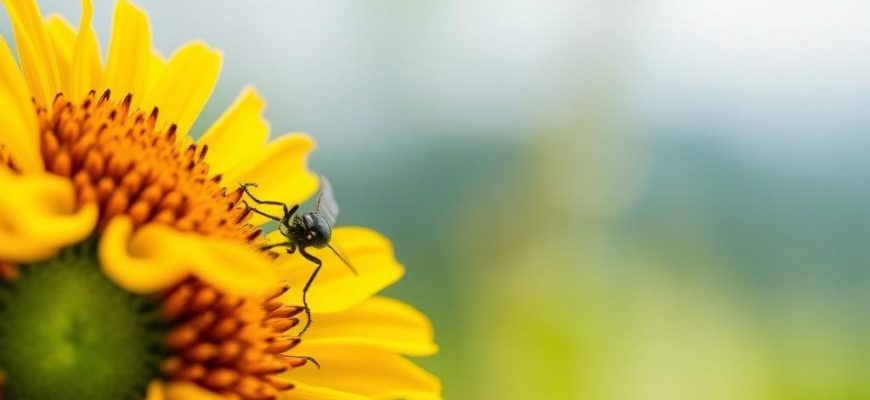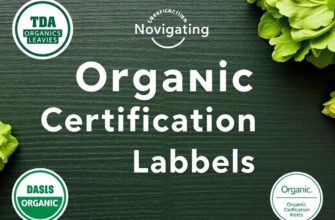Международное название:
Синонимы:
Характеристики:
| Сложность: | |
| Цикл развития: | |
| Световой режим: | |
| Режим полива: | |
| Температура: | |
| Почва: | |
| Ключевая черта: |
Цвет листвы
Цвет бутонов
Размеры цветка
Систематика:
| Домен: | |
| Царство: | |
| Отдел: | |
| Класс: | |
| Порядок: | |
| Семейство: | |
| Род: |
Organic pest and disease control is more than a set of tactics—it’s a mindset. If you’ve ever watched a beetle parade across your leaves or discovered a mold creeping along an otherwise promising harvest, you know how quickly stress can creep into a garden or farm. The good news is that with thoughtful planning, observation, and a toolbox of organic strategies, you can steer your plants toward resilience rather than simply reacting to disaster. In this article we’ll walk through practical approaches, from prevention and cultural practices to biological controls and safe organic sprays, so you can manage pests and diseases in a way that’s effective, sustainable, and gentle on the environment.
Organic approaches are about working with natural processes. Instead of relying on synthetic chemicals that can harm beneficial insects, pollinators, and soil life, organic methods emphasize soil health, biodiversity, and timely interventions that target problems without causing collateral damage. Whether you’re tending a small urban vegetable patch, caring for a few houseplants, or managing field crops, the same core ideas apply: prevent problems through design and good habits, monitor regularly, and use non-disruptive tactics first. We’ll unpack these principles in detail, give you concrete steps to implement, and provide recipes, tables, and lists you can refer to when trouble appears.
This is a long-read meant to be both practical and inspiring. If you prefer a quick checklist, look for the tables and bullet lists as you scroll—they consolidate the most useful actions. Otherwise, settle in and let’s explore how to craft a healthy, resilient growing environment that minimizes pests and disease using the power of organic methods.
- Understanding the Principles Behind Organic Control
- Prevention: The First and Most Powerful Strategy
- Choose Resistant Varieties
- Rotate Crops
- Improve Soil Health
- Design for Airflow and Sunlight
- Sanitation and Clean Tools
- Healthy Watering Practices
- Encourage Biodiversity
- Monitoring: Know Your Enemy
- Inspect Regularly
- Use Traps and Sticky Cards
- Keep Records
- Identify Accurately
- Biological Controls: Use Nature’s Helpers
- Beneficial Insects and Predators
- Entomopathogenic Nematodes and Microbes
- Soil Microbial Amendments
- Mechanical and Physical Controls
- Hand-Picking and Pruning
- Row Covers and Barriers
- Traps and Baits
- Temperature and Moisture Management
- Cultural Controls: Everyday Habits That Reduce Risk
- Timing Planting and Harvest
- Intercropping and Companion Planting
- Thinning and Proper Density
- Sanitary Harvest and Storage
- Organic Pesticides and Botanical Sprays
- Botanical Options
- Homemade Sprays
- Applying Sprays Wisely
- Dealing with Common Pests Organically
- Aphids
- Slugs and Snails
- Caterpillars and Loopers
- Whiteflies and Thrips
- Root-Knot Nematodes
- Managing Plant Diseases Organically
- Fungal Diseases (Powdery Mildew, Blight, Rust)
- Bacterial Diseases
- Viral Diseases
- Practical Tools, Storage, and Record Keeping
- Essential Tools
- Storage and Product Handling
- Record Keeping and Thresholds
- Common Mistakes and How to Avoid Them
- Overreliance on Organic Sprays
- Misidentification
- Poor Timing
- Not Addressing the Root Cause
- Scaling from Balcony to Farm
- Practical Weekly Checklist for Gardeners
- Case Studies: Real-World Successes
- Community Garden Tomato Blight
- Organic Apple Orchard Codling Moth
- When to Seek Professional or Extension Help
- Conclusion
Understanding the Principles Behind Organic Control
Before diving into specific techniques, it helps to understand the logic that unites them. Organic control rests on a few core principles: prevention, balance, monitoring, targeted action, and restoration. Prevention reduces the chance of problems ever taking hold. Balance emphasizes biodiversity—diverse ecosystems tend to self-regulate. Monitoring allows you to detect issues early when they’re easier to manage. Targeted action means using the least disruptive tools first—mechanical removal, barriers, or targeted biologicals—only escalating if necessary. Restoration focuses on healing the underlying conditions that allowed pests or disease to thrive, often by improving soil health.
Think of a garden as an ecosystem. A healthy system with strong, well-nourished plants and rich soil biology creates natural checks and balances against pests and disease. Many pests exploit stress—overwatering, compacted soil, nutrient imbalance, or repeated monoculture plantings. Diseases, particularly fungal and bacterial pathogens, often take advantage of crowded plantings and poor air circulation. Shift the conditions away from stress and you’ll reduce the frequency and severity of outbreaks.
Integrated Pest Management (IPM) is a framework that aligns with organic principles. IPM isn’t strictly organic or synthetic—it’s a decision-making process: monitor, identify, evaluate thresholds, implement controls (starting with cultural and biological), and assess outcomes. Organic practitioners apply IPM using approved organic tools, focusing on prevention and non-chemical controls first.
Prevention: The First and Most Powerful Strategy
When it comes to organic control, prevention is the best medicine. Preventive practices reduce the need for reactive interventions and are often the most cost-effective long-term.
Choose Resistant Varieties
Selecting disease-resistant and pest-resistant cultivars is one of the easiest and most powerful preventive steps. Plant breeders have developed many varieties that are less susceptible to common problems like blight, powdery mildew, or particular insect pests. Check seed catalogs and plant tags for resistant varieties. While not foolproof, resistance reduces pressure and lowers the likelihood of large outbreaks.
Rotate Crops
Crop rotation breaks pest and disease life cycles that build up when the same plant family is grown repeatedly in the same spot. Rotate plant families across beds or fields—avoid planting solanaceous crops (tomatoes, peppers, potatoes) in the same place year after year. A simple rotation plan can significantly reduce soil-borne disease and pest carryover.
Improve Soil Health
Healthy soil leads to vigorous plants. Incorporate organic matter regularly—compost, well-rotted manure, green manures, and cover crops—to improve structure, drainage, and microbial diversity. A biologically active soil supports beneficial microbes that suppress pathogens and increase plant resilience.
Design for Airflow and Sunlight
Many fungal diseases thrive in damp, shaded environments. Proper spacing, pruning for airflow, positioning beds to maximize sunlight, and avoiding late-afternoon watering can reduce disease friendly conditions. Orientation and layout matter—consider shade patterns and wind when designing a garden.
Sanitation and Clean Tools
Disease organisms travel on tools, stakes, and gloves. Clean and disinfect pruning tools between plants, remove diseased plant material promptly, and compost or dispose of infected debris (do not compost severely infected tissue unless your composting process reaches high temperatures). Sanitation is a basic but vital habit.
Healthy Watering Practices
Overhead watering can spread spores and wet foliage for long periods—prime conditions for fungus. Use drip irrigation, soaker hoses, or water at the base of plants early in the day to allow leaves to dry quickly. Avoid watering late in the evening if possible.
Encourage Biodiversity
Planting a mix of species—flowers, herbs, cover crops, and perennials—creates an environment where predators, parasitoids, and pollinators thrive. Diverse gardens are more resilient because pests have a harder time finding and dominating their preferred hosts.
Monitoring: Know Your Enemy

You can’t manage what you don’t see. Regular monitoring is the second critical pillar. A few minutes each week can save you weeks of headaches later.
Inspect Regularly
Walk your garden weekly—look under leaves, along stems, and at root collars. Identify early signs: chewed edges, holes, stippling, yellowing, spots, wilting, sticky honeydew, or visible pests. Learn to distinguish minor cosmetic damage from true, spreading threats.
Use Traps and Sticky Cards
Yellow sticky traps attract many flying pests like whiteflies and thrips; pheromone traps can alert you to specific moth pests. Traps act as monitoring tools and can reduce populations when used correctly.
Keep Records
A simple log with dates, observations, weather conditions, and treatments helps you spot patterns and evaluate what works. Record-keeping is invaluable for long-term improvement, especially on larger acreage.
Identify Accurately
Before choosing an action, identify the pest or disease. Treatments differ between chewing insects, sucking insects, fungal pathogens, and bacterial pathogens. Misidentification leads to wasted effort and sometimes worsens the problem.
Biological Controls: Use Nature’s Helpers
Biological control uses living organisms to suppress pests and diseases. Beneficial insects, nematodes, and microbial soil amendments can be powerful allies.
Beneficial Insects and Predators
Lady beetles, lacewings, predatory mites, ground beetles, parasitic wasps, and hoverfly larvae prey on many garden pests. Encourage them by planting nectar-rich flowers (umbellifers, asters, and buckwheat), providing habitats like hedgerows or brush piles, and avoiding broad-spectrum organic sprays that can kill beneficials.
– Release commercially available beneficials where appropriate: predatory mites for spider mite outbreaks, beneficial nematodes for soil-dwelling immature stages, or Trichogramma wasps for egg-stage caterpillars. Know the biology and timing to ensure released beneficials survive and make an impact.
Entomopathogenic Nematodes and Microbes
Nematodes such as Steinernema and Heterorhabditis species attack soil-dwelling larvae (e.g., grubs, weevils) and are applied in water under specific conditions. Microbial insecticides like Bacillus thuringiensis (Bt) target caterpillars and are highly specific, sparing beneficial insects when used correctly. Beauveria bassiana and Metarhizium fungi can infect pests like aphids and whiteflies.
Soil Microbial Amendments
Mycorrhizal fungi and beneficial bacteria (e.g., Bacillus spp., Pseudomonas fluorescens) can improve nutrient uptake and help suppress soil-borne pathogens. Compost teas and well-made compost introduce diverse microbial populations that compete with pathogens.
Mechanical and Physical Controls
Simple physical barriers and mechanical actions often work surprisingly well and are safe, inexpensive, and organic.
Hand-Picking and Pruning
For small gardens, hand-picking slugs, caterpillars, or beetles in the morning can dramatically reduce populations. Prune out diseased branches, spent flowers, and infested tissue to stop spread. Bag and remove the material away from the garden.
Row Covers and Barriers
Floating row covers prevent egg-laying and feeding by many pests—use them early in the season to protect seedlings from flea beetles or cabbage moths. Collars around seedlings protect against cutworms. Mulch can act as a barrier against soil-splashing that spreads fungal spores.
Traps and Baits
Beer traps and boards can reduce slug populations; pheromone traps attract and monitor moth pests. Trapping is often non-toxic and limits chemical dependency. For rodents, use humane traps or exclusion methods rather than poisons which can harm predators.
Temperature and Moisture Management
Solarization—covering soil with clear plastic during hot months—can reduce soil-borne pathogens and weed seeds in small plots by raising soil temperatures. Control moisture levels to reduce root rot and fungal diseases; ensure good drainage and avoid overwatering.
Cultural Controls: Everyday Habits That Reduce Risk
Daily and seasonal habits have cumulative effects. Think of cultural controls as garden hygiene and scheduling.
Timing Planting and Harvest
Adjust planting times to avoid peak pest periods. Early planting or late-season varieties sometimes escape peak pest pressure. Harvest promptly when crops mature—delays can invite pests.
Intercropping and Companion Planting
Interplanting aromatic herbs (basil, dill, rosemary) and flowers (marigolds, nasturtiums) can confuse pests, attract beneficials, or repel specific insects. While companion planting is not a cure-all, it contributes to diversity and can deter or reduce certain pests.
Thinning and Proper Density
Thinning seedlings and spacing plants appropriately improve air circulation and reduce humidity around foliage, minimizing fungal disease. Dense planting can increase competition and stress, making plants more vulnerable.
Sanitary Harvest and Storage
Harvest carefully to avoid bruising, clean produce before storage if needed, and store at the correct humidity and temperature to reduce post-harvest diseases. Remove and compost any spoiled produce quickly.
Organic Pesticides and Botanical Sprays
Sometimes organic-approved sprays are necessary. Use them judiciously, targeted, and only when monitoring indicates thresholds have been exceeded.
Botanical Options
– Neem oil: Extracted from the neem tree, it disrupts insect feeding and reproduction and has some fungicidal properties. It’s best used in the evening or early morning and should be washed off before pollinator activity.
– Pyrethrum (pyrethrin): Derived from chrysanthemum flowers, pyrethrins act quickly on many insects but can also harm beneficials, so use with care.
– Horticultural oil and insecticidal soaps: These physically smother small, soft-bodied pests like aphids, whiteflies, and mites. They work best on contact and require thorough coverage.
– Sulfur and copper fungicides: Used for fungal and some bacterial diseases, these are permitted in organic systems in limited applications. Overuse can harm soil life and plants—follow label directions and local organic standards.
Homemade Sprays
Many gardeners prepare simple sprays such as garlic-chili infusions, diluted soapy water, or baking soda mixtures for mild fungal control. Homemade remedies can help but are often less reliable and may need frequent reapplication. Always test a small area before widespread use and avoid sprays that harm pollinators.
Example homemade aphid spray (test and use responsibly):
- 1 liter water
- 1 teaspoon mild liquid soap (non-detergent)
- Optional: 1 teaspoon neem oil
- Mix gently and spray on affected plants, targeting undersides of leaves in the early morning or late evening.
Applying Sprays Wisely
– Spray in the cooler parts of the day to reduce plant stress and avoid harming pollinators.
– Avoid spraying when bees are active.
– Apply only to the affected area, and use the lowest effective concentration.
– Rotate products and methods to reduce the risk of resistance.
Dealing with Common Pests Organically
Let’s walk through practical approaches to common problems you’ll likely face.
Aphids
Aphids feed on sap and excrete honeydew that leads to fungal growth. Early intervention keeps populations low.
- Introduce or attract lady beetles, lacewings, and hoverflies.
- Use strong water sprays to dislodge them on small plants.
- Apply insecticidal soap or neem oil for heavy infestations, focusing on nymph clusters.
- Control ants because they protect aphids from predators.
Slugs and Snails
Slugs are night feeders and love moist, cool spots.
- Set beer traps or boards for manual removal.
- Use copper barriers or diatomaceous earth around seedling collars.
- Encourage natural predators: ducks, birds, and frogs.
- Water early to reduce evening moisture that favors slugs.
Caterpillars and Loopers
Caterpillars can defoliate quickly but many are controllable with Bt or hand-picking.
- Monitor for egg masses and remove them.
- Release Trichogramma wasps or use Bt spray for young caterpillars.
- Encourage birds and predatory wasps that feed on caterpillars.
Whiteflies and Thrips
These are common in greenhouses and warm climates.
- Use yellow sticky traps to monitor and reduce adults.
- Introduce predatory mites and parasitic wasps (Encarsia, Eretmocerus).
- Apply insecticidal soap or horticultural oil on contact.
- Maintain good airflow and sanitation to reduce outbreaks.
Root-Knot Nematodes
Soil nematodes cause root galls and stunting.
- Use resistant varieties and rotate crops that are non-hosts.
- Grow nematode-suppressing cover crops like marigolds (Tagetes).
- Improve organic matter and soil biology—beneficial microbes can help keep populations in check.
Managing Plant Diseases Organically
Diseases often need different strategies than insects. Here’s how to handle the common microbial threats.
Fungal Diseases (Powdery Mildew, Blight, Rust)
Fungal pathogens thrive on moisture and poor air circulation.
- Promote airflow and reduce leaf wetness—prune and space plants, use drip irrigation.
- Remove and destroy infected leaves and debris.
- Apply sulfur or potassium bicarbonate for powdery mildew when necessary.
- Use resistant cultivars and rotate susceptible crops.
Bacterial Diseases
Bacterial pathogens often enter through wounds and spread with water and splash.
- Avoid overhead watering and handle plants gently to minimize wounds.
- Sanitize tools and remove infected plants early.
- Maintain good soil health to encourage antagonistic microbes.
Viral Diseases
Viruses are tricky—no chemical cures exist. Prevention and vector control are key.
- Buy virus-free seed and transplants when possible.
- Control insect vectors like aphids and whiteflies with traps and predators.
- Remove infected plants promptly to limit spread.
Practical Tools, Storage, and Record Keeping
A well-organized approach makes organic control manageable at scale.
Essential Tools
Keep these on hand: sharp pruning shears, hand lens for inspection, sticky traps, row covers, sampling bags, and a spray rig for organic emulsions. Invest in a compost thermometer and pH kit if you manage compost and soil health regularly.
Storage and Product Handling
Store organic pesticides, oils, and biologics in a cool, dry place and keep labels with them. Many biological products have a limited shelf life and require refrigeration.
Record Keeping and Thresholds
Set action thresholds for common pests—for instance, one aphid cluster per plant might demand action on seedlings but not on mature, vigorous perennials. Use a simple spreadsheet or notebook to track pest counts, weather conditions, and treatment results.
Common Mistakes and How to Avoid Them

Even with the best intentions, gardeners make avoidable errors. Here are typical pitfalls and how to fix them.
Overreliance on Organic Sprays
Just because a product is organic doesn’t mean it’s harmless. Overuse harms beneficials and soils. Use sprays as a last resort and rotate approaches.
Misidentification
Mistaking beneficial insects for pests or misdiagnosing a disease leads to wrong actions. Spend time learning key pest signatures and use extension services or online communities for identification help.
Poor Timing
Applying controls at the wrong growth stage can be ineffective. Know the pest’s life cycle. For instance, Bt works on young caterpillars but not on late-stage larvae.
Not Addressing the Root Cause
Treating symptoms (like visible fungal lesions) without changing underlying conditions (poor drainage, recurring shade) invites repeat problems. Combine symptom control with environmental changes.
Scaling from Balcony to Farm

Organic strategies scale; the same principles apply whether you have five pots or five acres. The differences are logistical: monitoring becomes more systematic on larger plots, and biological releases or cover cropping require planning. Here’s a quick comparison table to guide scale-appropriate choices.
| Scale | Best Early Actions | Monitoring Tools | Practical Controls |
|---|---|---|---|
| Balcony/Small Garden | Companion planting, resistant varieties, hand removal | Visual checks, sticky traps | Row covers, hand-picking, soaps/oils |
| Backyard Garden | Rotation, compost, diverse plantings | Weekly inspections, pheromone traps, soil tests | Beneficial releases, diatomaceous earth, biologicals |
| Small Farm | Planned rotations, cover crops, soil biology program | Systematic scouting, trap networks, sampling | Commercial biocontrols, targeted organic sprays, solarization |
| Commercial Organic Farm | Field-level planning, integrated soil and pest management | Data-driven monitoring, record systems, thresholds | Biological control programs, crop diversification, certified inputs |
Practical Weekly Checklist for Gardeners
Use this short weekly checklist to stay ahead of problems.
- Walk all beds and inspect undersides of leaves and stem bases.
- Check sticky and pheromone traps; record counts.
- Remove any diseased tissue and dispose of it safely.
- Inspect soil moisture and adjust watering to avoid over- or under-watering.
- Encourage beneficials—add a small patch of flowering plants or leave a water source.
- Note any pest hotspots and set localized controls (hand-picking, traps).
- Record observations and conditions in your log.
Case Studies: Real-World Successes
Here are two short examples of how organic strategies play out.
Community Garden Tomato Blight
A community garden faced late blight in tomatoes. They combined resistant varieties the next season, increased spacing, switched to drip irrigation, and removed volunteer nightshades promptly. When spores appeared, they used copper sprays carefully and introduced disease-suppressive compost. Result: blight incidence dropped dramatically over two seasons because the environment had been altered to be less favorable to the pathogen.
Organic Apple Orchard Codling Moth
An orchard struggled with codling moth. Growers used mating disruption pheromone dispensers, released Trichogramma wasps to attack egg stages, and encouraged predatory birds with perches. They also practiced strict sanitation, removing dropped fruit promptly to break the lifecycle. Over three years, fruit damage dropped sufficiently to meet organic market standards without resorting to broad-spectrum insecticides.
When to Seek Professional or Extension Help
Sometimes, despite best efforts, a problem becomes overwhelming. Seek extension services, certified organic agronomists, or experienced gardeners when:
- The pest or disease is spreading rapidly and you can’t identify it.
- Home remedies and basic organic tools don’t reduce the problem.
- You need help planning rotations or selecting resistant varieties for a larger scale operation.
Extension agents can provide lab diagnosis for difficult diseases, recommend region-specific strategies, and help identify allowable organic inputs for certified operations.
Conclusion
Organic pest and disease control is an achievable goal that hinges on prevention, observation, and thoughtful use of nature-based tools. By improving soil health, encouraging diversity, monitoring carefully, and using mechanical, biological, and targeted organic interventions, you can manage most problems without heavy reliance on synthetic chemicals. The approach requires patience and learning—mistakes will happen—but the payoff is healthier plants, safer food, and a garden or farm that supports rather than depletes the surrounding ecosystem. Keep records, adapt seasonally, and remember that a resilient system builds over time; every small improvement reduces future pest pressure and makes your growing space more productive and enjoyable.
Оценивайте статью, делитесь материалом с друзьями в социальных сетях, а также высказывайте свое мнение в обсуждении ниже! ![]()







